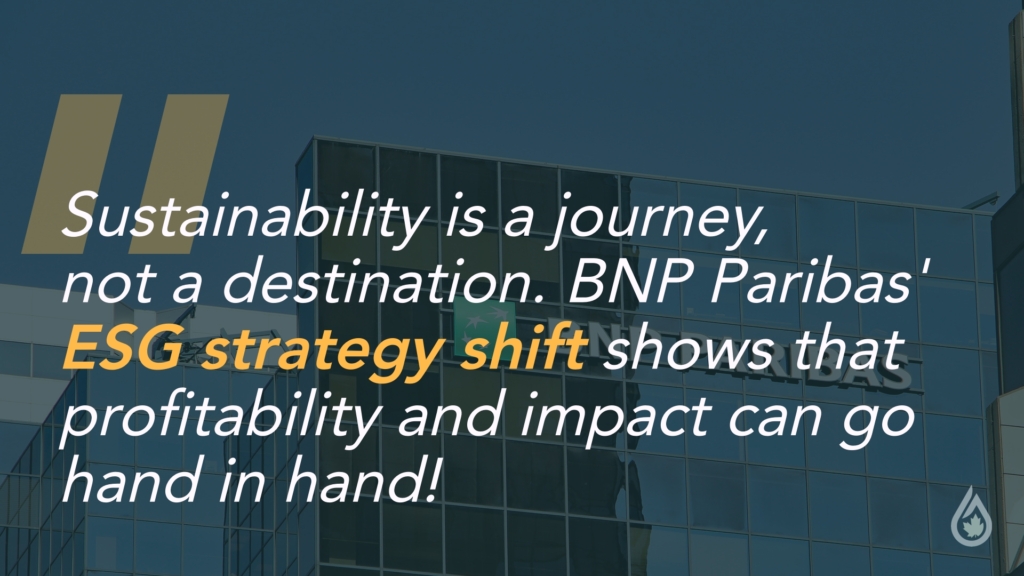BNP Paribas ESG Shift: What It Means for You
BNP Paribas (BNPP.PA), one of Europe’s largest banks, has announced a bold new approach to sustainable finance, marking a significant BNP Paribas ESG strategy shift. This decision aims to align the bank’s sustainability goals with profitability, creating new opportunities in the evolving ESG investment landscape. What does this mean for you as the investor, the environmentally conscious consumer, or the business leader though? Let’s explore this BNP Paribas ESG strategy shift, its implications, and the actions you can take to navigate the changes.
A New Direction for BNP Paribas’ ESG Strategy
The BNP Paribas ESG strategy shift represents a pivot from traditional exclusion-based investment models to a broader, more adaptive framework. The bank is now focusing on four key themes: adaptation, transition, conservation, and societal resilience. This new direction is driven by a need to balance environmental and societal impact with financial returns.
Key elements of the shift:
- Expanding Sustainability Criteria: Instead of outright exclusions, BNP Paribas plans to support decarbonizing industries such as cement and steel.
- Investing in Climate Initiatives: Funding renewable energy, water management, and agri-business remains a priority.
- Balancing Profitability and Impact: The bank aims to demonstrate that financial viability and sustainability can go hand in hand.
This change in strategy acknowledges the economic challenges and criticisms facing traditional ESG investments while positioning itself as a leader in innovative sustainable finance.
What the BNP Paribas ESG Strategy Shift Means for You
This decision affects individuals across the spectrum and, whether you’re an investor, consumer, or business leader, you need to pay attention to this. Understanding this strategy shift empowers you to adapt and thrive in the evolving ESG landscape.

For Investors
BNP Paribas’ move creates more diversified ESG investment opportunities and the bank offers a path for sustainable growth in sectors previously excluded by including transition-focused industries
Takeaway:
- Explore investments tied to decarbonization in high-impact industries.
- Review portfolios to align with the evolving ESG framework.
For Consumers
As businesses gain access to funding for sustainability transitions, products and services aligned with ESG values may become more widely available. BNP Paribas actions emphasizes accountability, making it easier to support companies genuinely committed to sustainability.
Takeaway:
- Continue supporting brands that demonstrate clear ESG progress.
- Validate ESG claims through trusted reporting channels.
For Business Leaders
The BNP Paribas ESG strategy shift provides new funding opportunities for carbon-intensive industries committed to reducing their environmental impact. Companies now have a greater chance to secure resources for meaningful transitions.
Takeaway:
- Develop clear, actionable sustainability roadmaps.
- Collaborate with stakeholders to demonstrate your commitment to ESG principles.
Taking Precautionary Measures in Light of BNP Paribas’ ESG Shift
Navigating this strategy shift requires proactive steps to ensure alignment with the new ESG landscape. Here’s what you can do:
For Investors:
- Diversify Investments: Explore emerging opportunities in transition-focused industries.
- Engage with Fund Managers: Ensure transparency in how funds are aligned with the new ESG strategies.
For Consumers:
- Research ESG Claims: Support businesses with verified sustainability efforts.
- Encourage Innovation: Choose products from companies actively working towards decarbonization.
For Businesses:
- Embrace Adaptation: Develop strategies to align with sustainability funding criteria.
- Showcase Progress: Transparently communicate ESG initiatives to build trust and attract investment.
Why ESG Still Matters Despite the Shift
Some may view this BNP Paribas ESG strategy shift as a retreat from ESG’s original principles, however, it’s important to see it as a necessary evolution. Balancing sustainability with financial viability ensures the long-term success of ESG initiatives.
Key reasons ESG remains critical:
- Global Challenges Persist: Issues like climate change and resource scarcity require sustainable solutions.
- Stakeholder Demands: Consumers and investors continue to expect transparency and accountability.
- Resilient Sustainability: Aligning ESG with profitability makes it more adaptable to changing political and economic environments.
This BNP Paribas ESG strategy shift demonstrates that sustainability and financial performance can coexist, paving the way for a stronger, more resilient ESG framework.
Your Call to Action
Whether you’re investing, purchasing, or leading a business, your actions matter and you have the power to shape the future of sustainable investing in light of the BNP Paribas ESG strategy shift.
Here’s what you can do today:
- Stay Informed: Follow trends in ESG and understand their implications for your finances and goals.
- Engage Proactively: Ask questions and demand transparency from fund managers, businesses, and stakeholders.
- Drive Change: Make choices that align with your values and advocate for accountability.
Conclusion
The BNP Paribas ESG strategy shift is a transformative moment in the world of sustainable finance. By broadening its approach, BNP Paribas is ensuring that ESG initiatives remain impactful and viable in the face of evolving challenges. This isn’t a step back for ESG; it’s a leap forward, opening new opportunities for investors, consumers, and businesses alike.
By taking informed, deliberate actions, you can both adapt to these changes and lead the way towards a sustainable future because the BNP Paribas ESG strategy shift is a reminder that sustainability is a journey, and you’re at the forefront of it.
Image by Can Pac Swire



